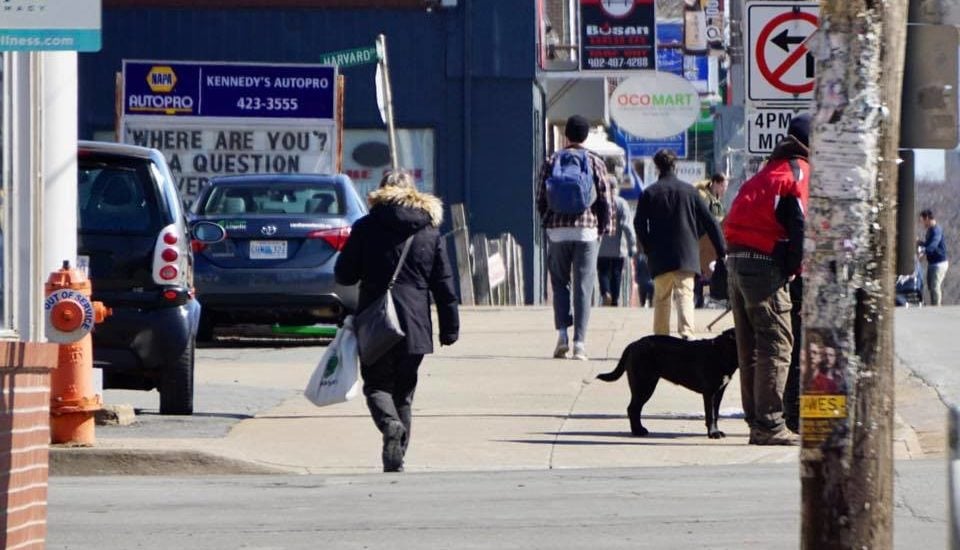
KJIPUKTUK (Halifax) – The Coronavirus crisis has brought to the forefront a perennial problem often swept under the carpet or pegged for gradual street redesigns over decades: How can we enable pedestrians of all ages and abilities to move around safely?
Our sidewalks are less than 1.5 metres wide, barely enough room to pass others. Crossing points are not safe by design, which presents particular issues for pedestrians with vision loss, restricted mobility or movement, and people with impaired and undeveloped mental awareness and judgement.
We need to be two metres apart from others, anywhere in public – the width of a three-seat sofa. This isn’t just advice, it’s now law: A 35 year old man was ticketed last week for failing to provide safe social distance to others in a bus shelter.
The social distance is critical because the virus is carried in minute water droplets produced when we cough or sneeze, even our breath. Passing someone coming from the other direction on the sidewalk brings us into contact with this “bioaerosol”. One doctor has suggested this could be more of a factor when passing someone breathing more heavily, such as a runner.
In the absence of any practical guidance or action from leadership on maintaining social distance on sidewalks, pedestrians are dealing with this issue by walking in the road when they pass others. This is easier for some than others and obviously impossible for anyone using a mobility scooter and wheelchair. It is also unsafe, especially in current conditions where many drivers are moving well in excess of the speed limit due to the lack of traffic
What could be done to make the movement of people on essential journeys safer? The most obvious and widely available method is to free up space from currently underused roads using road cones, bollards or temporary barriers, as completed already in many cities including London, Ontario.
This could be most useful along roads where shops selling essential supplies are still open, for example Spring Garden Road where traffic lanes are currently wider than is strictly required and recommended for urban routes. Also Quinpool Road, where police were reported to be ordering pedestrians to keep 6 feet apart.
We could also deploy temporary barriers along our very many overly wide and underused multiple-lane urban highway-style routes, for example Lacewood, Pleasant Street, Dunbrack and Joseph Howe Drive.These bloated roads are built wide to ensure traffic keeps moving even during peak periods, which is no longer a factor given so many are working from home or not working at all right now.
But could this just encourage more people to go out instead of staying at home? Yes it absolutely could. We know this because we have built our roads wide and fast for decades so people using cars can commute easily. This has encouraged very high levels of car use for commuting – 2016 census data revealed 78% of us commute by car. We haven’t made crossing points safe for use by all or adapted our roads for slower speeds, which has discouraged people from cycling, walking, wheeling and taking the bus.
So we can expect the exact same phenomenon if we use temporary measures to make our roads safer and easier for use by people. We will start seeing more people we have never seen out and about in our neighbourhood, of all ages and abilities. Is this unsafe? Not so long as there is sufficient space to make sure everyone can keep two metres apart. The temporary measures along with appropriate signage will act as a prompt for all to remember we absolutely need to maintain a safe distance from others, and give us plenty of room to effect that if we see others not being as careful around us. Most importantly it will allow those currently trapped in their homes to get out and about to get essential supplies and exercise.
So far, Waye Mason has pointed to lack of resources and staff as a reason for not deploying these temporary measures now. However we have heard Tim Outhit agree that the lack of traffic is a good opportunity to get ahead on pothole repairs, once the asphalt plants are open for the season.
We have road cones and temporary barriers which can be deployed quickly and easily. Leadership must make space for the safe and legal movement of people our first priority, not road repairs. Failing to do so puts us in the involuntary position of being law breakers and risk takers on our sidewalks.
These are unprecedented times which require unprecedented measures to change the status quo. Using the whip and keeping people contained in their homes for a (likely) extended period isn’t the solution nor the means to effect safety and comfort for all.
If you walk, cycle or use a wheelchair and are affected by road safety issues, please join HRM Safe Streets for Everyone. If your local crosswalk needs a crosswalk flag, please contact the Crosswalk Safety Society. Please remember to report issues affecting your safety to our municipal authorities using the 311 service.
With a special thanks to our generous donors who make publication of the Nova Scotia Advocate possible.
Subscribe to the Nova Scotia Advocate weekly digest and never miss an article again. It’s free!




We need a council that makes pedestrians priority #1.
We need a provincial government that legislates pedestrians as priority #1.
We need members of parliament to recognize pedestrians as priority #1; and we need them to spend infrastructure money on sidewalks for pedestrians.
Use of sidewalks should be limited to pedestrians.
The word pedestrian includes people in wheelchairs, people with a walker, people with a cane. We need wider sidewalks, at least 8 feet wide. In Dartmouth there are miles of streets that are almost 60 years old and have no sidewalks, in peninsula Halifax there are no such streets. There are miles of streets in suburban HRM that do not have sidewalks and there are no plans for sidewalks.
The latest HRM Capital budget has $3.5 million for sidewalks and $17 million for cycle lanes; is this acceptable ?
Thank you. Agree we need wider sidewalks, for all the reasons you say. But the problem isn’t the money being spent on bike lanes, it’s the money being spent on maintaining and building roads which are far in excess of what we need and are not in any way contributing to sustainable and safe transport in Halifax. We need those bike lanes. We also seriously need to review our spending on lanes mainly used for car use.
There are more pedestrians than cyclists. Why are pedestrians treated as second class citizens in HRM budgets ? Why is it OK to spend $5 for bike lanes and $1 for sidewalks ? Roads are needed for emergency vehicles. Over 100,000 cars cross the two bridges every weekday. How do you propose to move those people ? Is a nurse going to cycle to Cobequid or Oceanview for a 7 a.m. shift ?
And why do people in HRM oppose the twinning of the highway to Cape Breton ? One has to be wilfully ignorant of the vital lifeline for the supply of food and goods to people in Cape Breton and Newfoundland. A peninsula centric view flies in the face of reality.
These are all good questions. Cars never have been a good way to transport people in cities – they require too much space and expense and put great strain on resources at peak times when there is often only one person in each vehicle. Many vehicles people use for this purpose take up nearly half the space of a bus. I do not support Highway twinning or road building. I support investment in sustainable transport options that are ultimately cheaper and have a lower impact on others – public transport, cycle lanes, safe infrastructure for pedestrians, swapping traffic lanes for bus lanes and combining that with an efficient and reliable park and ride service, etc. The investment in bike lanes is because cyclists do not currently have safe, connected and protected routes for the purpose of commuting. Cities all over the world have encouraged far more cyclists where they have invested in protected, connected and safe infra for cyclists. I agree more could and should be invested in pedestrian infrastructure too, but that money could come from HRM’s road building and maintenance budget, which currently accommodates the Burnside Connector funding commitments.
Martyn, What reduction in car traffic over the bridges would you suggest and how would you attain the objective ?
I have lived in Dartmouth long enough to remember when we had to go to Halifax if we needed an operation. If you need cataract surgery you have to be at the old Infirmary by 6 a.m. If you need polyps removed you have to be at Cobequid by 6:30 a.m and a friend had ankle surgery at Windsor and had to be there by 6 a.m. Many people from the Atlantic Canada come to Halifax for treatment, and they drive or use the private vans – you can see them at the Infirmary and the QE2. Cycling if fine if you are a public sector 8:30 – 4:30 Monday to Friday employee on the peninsula. It is not fine if you are a homecare worker.
Why do you oppose highway twinning to Cape Breton ? I assume you know that Newfoundland relies on ferries loaded with trucks carrying food and material from Central Canada. Have you ever travelled on that highway ? Have you travelled the length and breadth of Nova Scotia ? My wife and I have.
The major problem in HRM is the fact that almost all public employment is on the peninsula and less than 70,000 people live on the peninsula; and many people commute a great distance from the peninsula. How do we replace 10% of the 100,000 cars crossing the bridges ? If a bus has 30 passengers we will need 333 buses. Not to mention all the buses to replace a portion of the cars from the Valley and the South shore. We can’t build subways, the cost is prohibitive.
The Burnside Connector is funded by the province and the federal government. If we ever get back to what it was like last November I suggest you drive over to Dartmouth and at 6:30 a.m sit at the bottom of the Magazine hill to Bedford and observe the lanes of vehicles headed to Burnside and Halifax. And the next day sit at the car dealership opposite Fairview container terminal and observe the 2 lanes of traffic inbound. And the next day go to the Armdale rotary and observe the 2 lanes of traffic inbound. Bike lanes won’t solve the problem. Transit won’t solve the problem. De-centralisation of public institutions is part of the solution. The new hospital should have been built in Sackville; and don’t forget all the fuss over building an out-patient facility in Bayers lake – Tristan Cleveland and his friends were very vocal opponents, arguing that it should be on the peninsular – a typical opinion by insular Haligonians who know next to nothing about the province they live in.
Good questions Colin, I’ll do my best to answer the key ones.
“How do we replace 10% of the 100,000 cars crossing the bridges ?”
We could replace up to 10% with cycling journeys, and much more given the right Park and Ride bus services. Most cities cannot support the extremely high % of people travelling by car here. North American cities are unique in the world regarding their desire to support cars with adequate road space.
“Why do you oppose highway twinning to Cape Breton ?”
The cost of Highway twinning in NS is extremely expensive – see recent news releases on that subject. The money would be better spent in my opinion on improving public transport, which allows people to move at less expense and space used on roads. Such as bus travel between cities.
Re the numbers of cars on Magazine Hill, etc. Yes this is a huge problem. It can only be solved by measures which ensure people travel by much more efficient modes of transport – buses, walking and cycling. Park and Ride is a powerhouse solution for smaller cities like Halifax and has been used successfully in other Canadian cities at a larger scale (Edmonton and Calgary for example).
Re the de-centralisation of public institutions – yes perhaps, but hospitals in urban centres can work so long as there are good public transport services which are quick and effective. Bus lanes can be utilised by both buses and emergency vehicles, so they can be an excellent solution.
Good questions Colin, I’ll do my best to answer the key ones.
“How do we replace 10% of the 100,000 cars crossing the bridges ?”
We could replace up to 10% with cycling journeys, and much more given the right Park and Ride bus services. Most cities cannot support the extremely high % of people travelling by car here. North American cities are unique in the world regarding their desire to support cars with adequate road space. This uses up a lot of valuable space in our urban core and it conflicts with the needs of businesses and housing.
“Why do you oppose highway twinning to Cape Breton ?”
The cost of Highway twinning in NS is extremely expensive – see recent news releases on that subject. The money would be better spent in my opinion on improving public transport, which allows people to move at less expense and space used on roads. Such as bus travel between cities.
Re the numbers of cars on Magazine Hill, etc. Yes this is a huge problem. It can only be solved by measures which ensure people travel by much more efficient modes of transport – buses, walking and cycling. Park and Ride is a powerhouse solution for smaller cities like Halifax and has been used successfully in other Canadian cities at a larger scale (Edmonton and Calgary for example).
Re the decentralisation of public institutions – yes perhaps, but hospitals in urban centres can work so long as there are good public transport services which are quick and effective. Bus lanes can be utilised by both buses and emergency vehicles, so they can be an excellent solution.